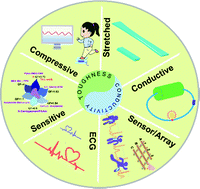A hydrogel sensor driven by sodium carboxymethyl starch with synergistic enhancement of toughness and conductivity†
Abstract
Conductive hydrogels are potential materials for fabricating wearable strain sensors owing to their excellent mechanical properties and high conductivity. However, it is a challenge to simultaneously enhance the mechanical properties and conductivity of hydrogels. Herein, a simple strategy was proposed for concurrently enhancing the mechanical properties and conductivity of the wearable hydrogel sensors by introducing carboxymethyl starch sodium (CMS). The introduction of CMS not only dramatically enhanced the mechanical performance of the hydrogel due to hydrogen bonding and electrostatic interaction, but also improved the conductivity of the hydrogel owing to the existence of sodium ions. As a result, the hydrogel sensors with excellent durability and stability could repeatedly detect and distinguish various human activities, including walking, chewing and speaking. Meanwhile, multiple sensors are also assembled into a 3D sensor array for detecting the three-dimensional distribution of stress and strain. Moreover, the peaks of EMG signals and the waveforms of ECG signals could be recorded because the hydrogel sensor presented super sensitivity and fast response. Therefore, the multifunctional hydrogel presented remarkable potential for applications in human medical diagnosis, health monitoring and artificial intelligence.



 Please wait while we load your content...
Please wait while we load your content...